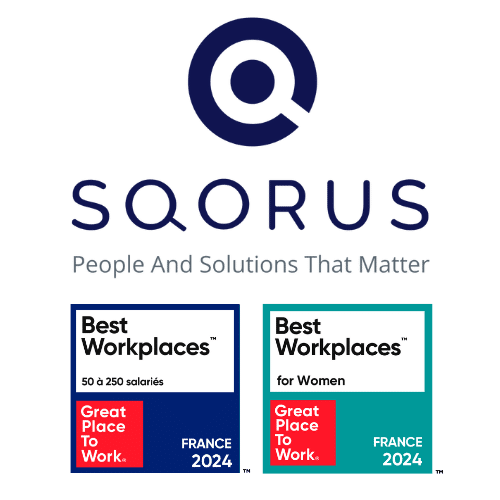Before we start looking at Inclusion and Diversity (also known as DEI for Diversity, Equity, and Inclusion) in the workplace, let’s review the basics.
What is diversity and inclusion?
Diversity
Diversity is the representation of varied profiles (representative of the Company) within a company. We’re talking about diversity: gender identity, age, ethnic, social or cultural origin, religion, sexual orientation, cognitive (neurodiversity), etc.
Inclusion
Inclusion is about creating an environment in which people feel comfortable, physically and psychologically safe, in their place and treated as equals.
It focuses on interactions and making diversity work.
We can sum up the nuance between these 2 notions by quoting Vernā Myers, (VP, Inclusion Strategy at Netflix) ” Diversity means being invited to the party. Inclusion means being invited to dance “. Or Caroline Chavier, CEO of The Allyance, if you want to bring them back to the business world: ” Diversity is a recruitment issue, whileinclusion is a management, HR and cultural issue”.
While the concept has been around for many years now, the subject of diversity andinclusion is becoming increasingly important in the corporate world.
The rise of diversity and inclusion
In the era of the #Metoo and Black Lives Matter movements, to name but a few, and the accompanying awakening of awareness, implementing and promoting an IED policy has become indispensable.
Any company wishing to attract talent and enhance its image in the marketplace must work on it.
Indeed, for Millenials and Generation Z in particular, a company’s commitment to inclusion & diversity is a very important factor (today, 4 out of 5 young people would work for a company that shares the same commitments and values). genZ gives priority to values and will not go into companies that do not reflect this.
Companies have understood this, and almost all of them have embarked on D&I policies of varying degrees of ambition.
Diversity and inclusion: pitfalls to avoid
However, we must be careful not to presuppose that diversity implies inclusion, or to take a superficial or quantitative view of the subject. Indeed, as Robin J. Ely and David A. Thomas point out in their Harvard Business Review article, ” Increasing the number of historically underrepresented people in the workforce does not automatically translate into beneficial effects.”
Another example is Pete Stone, author of a report on inclusion in organizations for the AFMD, who points out that ” it’s not enough to have women on a Council to be inclusive, you have to let them have their say and listen to them “. There’s a name for hiring individuals from minority backgrounds in order to promote diversity, but without any real commitment or weight in the company’s decision-making process: Diversity Washing.
And while many studies point to diversity in the workplace as a lever for performance, diversity washing will have the opposite effect: loss of trust, deterioration of image, flight of talent…
Inclusive recruitment is therefore a good starting point, but not sufficient to create real coherence between the rhetoric and reality of an inclusive company.
It seems that in France, more managers than in other countries think that D&I is a purely HR issue; yet, to be successful, it must be driven by managers and their exemplarity in this area. And to make this possible, it’s essential that top management gets to grips with the subject and supports human resources. It’s a project that requires a long-term vision and a major investment.
Diversity and inclusion: the foundations of a good strategy
Implementing a D&I strategy doesn’t have to be purely quantitative or financial. It has to put people and ethics at the center, and get everyone on board. It must be part of the company’ s culture and values, and visible on a daily basis.
Here are some important points to bear in mind:
Confidence
Even today, many employees say they feel uncomfortable and don’t dare broach the subject of diversity. Employees need to feel free to express themselves, their point of view, and their vulnerability, so that all issues can be addressed and dealt with.
This ensures that no one is left out. It’s important to reach out to employees, listen to them and get them involved. But we also need to take into account their feedback on what works well and can be rolled out more widely, and what doesn’t work so well and needs to be stopped or adjusted.
Full management involvement
For a culture fully imbued with the subject, it is important that learning and action take place at both individual AND collective levels, in order to bring about systemic change (deconstruction and reconstruction may sometimes be necessary, and encouraging managers to learn and read about discrimination is important).
Implement concrete actions
The philosophy must be accompanied by awareness-raising and training initiatives, as well as concrete sanctions against discrimination. These measures must of course be accompanied by impact monitoring and adjustments if necessary.
Accept a wide range of styles and points of view
Everyone must be able to feel comfortable enough to be themselves without fear of judgment or negative consequences, otherwise self-censorship will prevail over the multiplicity of ideas and points of view that make up the richness of diversity.
The feedback given to the various individuals must relate to the real expectations of the position or assigned tasks, and not to the individuals themselves, at the risk of conveying the message that they must always be attentive to how others perceive them.
These different styles and points of view, when respected and welcomed, serve learning and enable the enrichment of ideas, innovations and therefore performance.
The continuing challenges of diversity and inclusion in the workplace
While the benefits of diversity and inclusion are undeniable, it’s essential to recognize the persistent challenges organizations can face when trying to implement effective D&I policies:
Resistance to change
Resistance to change is common, as the introduction of diversity and inclusion policies can disrupt existing structures and work habits.
What’s more, some organizations may have deeply-rooted corporate cultures that are resistant to change. Cultural adaptation can be a long and demanding process.
Measuring impact
Measuring the real impact of diversity and inclusion policies can be complex. It is often difficult to quantify tangible short-term results.
This is partly due to the subjective nature of cultural change, and the difficulty of isolating the specific effects of D&I initiatives from the many factors influencing the company.
To meet this challenge, companies need to combine quantitative and qualitative data, keep up to date with best measurement practices, and commit to ongoing, long-term monitoring. Despite these obstacles, impact measurement is becoming an essential part of strategic diversity and inclusion management, as it enables progress to be quantified and the benefits of these initiatives to be maximized.
The need for further training
Awareness of diversity and inclusion must be constantly nurtured.
While initial awareness programs are essential for introducing employees to diversity concepts, they are not enough to maintain an inclusive culture over the long term.
Organizations must invest in ongoing training to maintain their inclusive culture.
This training must use a variety of pedagogical tools and be adapted to individual needs. It must also be integrated into employees’ professional development to ensure that it is not perceived as a separate task, but as an essential component of the corporate culture.
Conclusion on diversity & inclusion in the workplace
To sum up, while quotas and incentives (sanctions, regulations, etc.) have made it possible to initiate certain actions and get things moving (particularly in terms of gender diversity), they are not sufficient in themselves to bring about a major change in attitudes, management or strategy.
While we can see that companies have taken a stronger grip on the subject in recent years, with the arrival of Diversity Directors or entire departments dedicated to the subject, we can nevertheless hope that they will disappear. It would be a sign that diversity and inclusion were so deeply rooted in the culture, that everyone could be its ambassador.
SQORUS is here to help you with this. Do not hesitate to contact us to discuss this with our experts.
35 HR innovations and trends for 2024
Discover the latest HR innovations and trends and accelerate your digital transformation.
Also read in our Issues and Innovations feature:
- 4 preconceived notions to deconstruct about CSR
- What is the metaverse?
- Metavers: the first controversies
- The metaverse at the service of training
- 7 HR issues and trends for 2023
- Generation Y is changing the way work is organized: an opportunity for companies!
- Corporate training: a transformation in progress?
- Continuous feedback: towards a new management style?
- HR innovation: what can we expect in the coming years?
- Big data and BI: from predictive to prescriptive analysis
- Infrastructure as code: why is it a key IT issue for the future?
- IT containerization is changing application development
- Low code platform: the future of application development?
- SOA and microservices: what are the benefits for an enterprise?
Contact
A project? A request?A question?
Contact us today and find out how we can work together to make your company’s digital future a reality.













